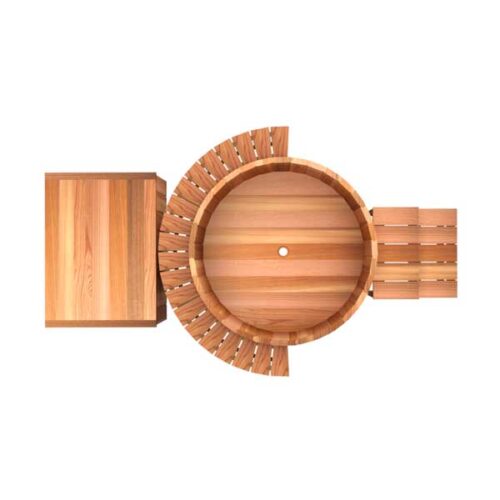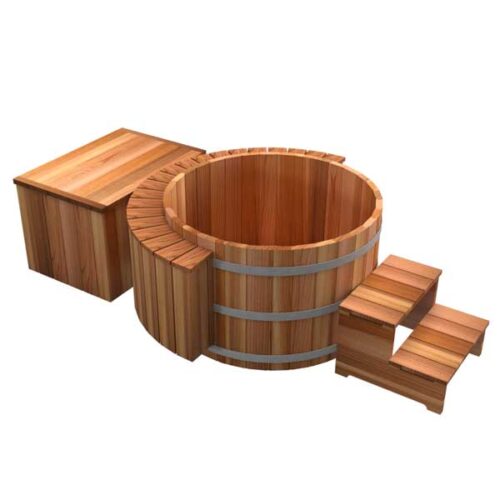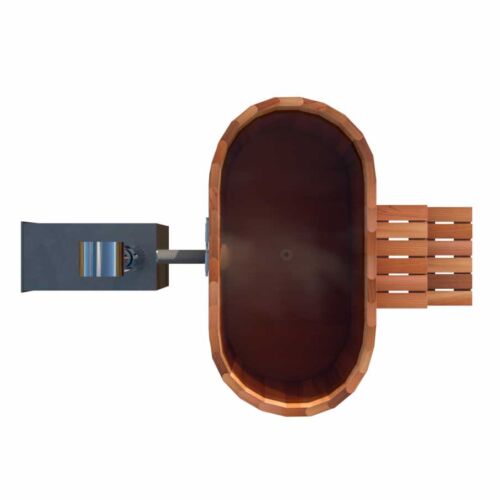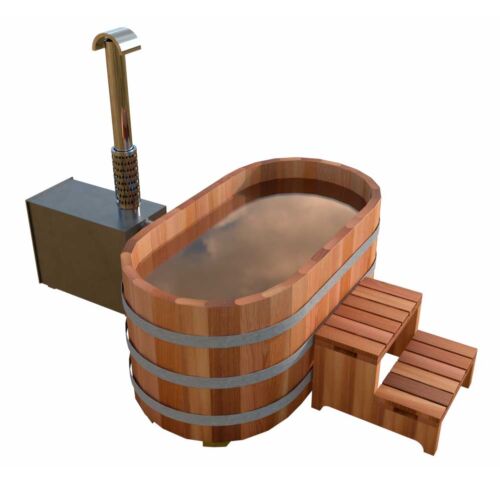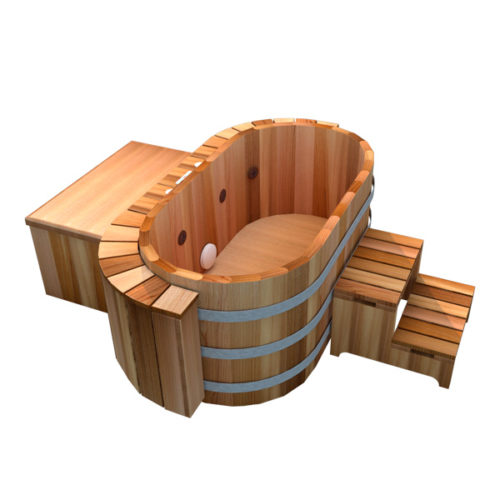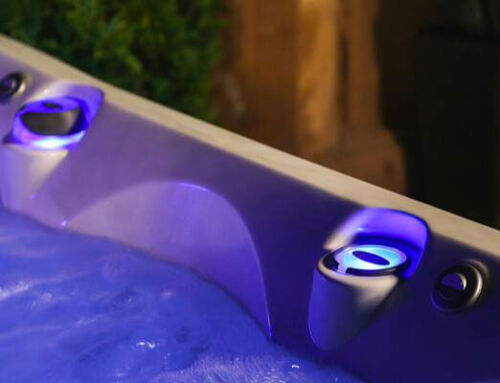Why is a Cedar Wood Tub better than a Plastic Spa?
Hot Tubs and Healthy living
Hot tubs are all about healthy living and melting away the stresses of a hectic life. Half the enjoyment of a hot tub is sharing it with someone. The last thing one wants to worry about is catching your hot tub partner’s germs.
Most owners of hot tubs, or users of public hot tubs, have at some stage heard warnings about bad things that can happen to you in an insanitary hot tub. Don’t be alarmed. Micro-organisms in contaminated hot tubs and spas, causing illness, are easily prevented, especially if you are bathing in a cedar wood hot tub, because the wood provides a natural defence by actively combatting bacteria and fungi.
When is one at risk in a hot tub?
When is one at risk of catching a communicable disease in a hot tub? Usually if the water is not properly treated and maintained. The biggest risk is clearly in a dubious spa at a public resort, but it is prudent to ensure your own hot tub’s water remains free of bacteria and fungi.
To be able to prevent and treat any potential ailments sometimes associated with contaminated hot tub water, it is best to understand what causes them, how they can be treated and how they can be eradicated from your hot tub.
What ailments are associated with hot tubs?
Hot Tub Rash:
One of the most common warnings is about Pseudomonas Dermatitis, or folliculitis, commonly known as hot tub rash. The rash is caused by soaking in contaminated water in swimming pools, lakes and hot tubs. The culprits are tiny bacteria (Pseudomonas aeruginosa) naturally found in soil and water. They thrive on warmth and air, both found in hot tubs, but can be eliminated quite easily.
The bacteria get trapped in your hair follicles if you soak in contaminated water for long periods of time. They are caused in a similar way to pimples and break out as a bumpy rash, hence the name.
If untreated, people with compromised immune systems and younger children might be at risk of more severe symptoms such as fever, upper respiratory tract complications and inflammation.
Legionella and Pseudomonas
People are particularly concerned about the serious sounding legionella, a type of bacterium that causes Legionnaires’ disease. It causes flu-like symptoms and people could be put at risk of pneumonia.
These bacteria are also widespread in nature, but only become dangerous when they colonise in polluted water systems, such as ice machines, water fountains, swimming pools, spas and hot tubs. The bacteria (L. pneumophila) are similar to amoeba and human cells and in nature infect freshwater and soil.
The bacteria must be inhaled to cause disease. When people breathe in the bacteria, they may develop “granulomas,” or small areas of inflammation, in their lungs. This is sometimes referred to as “hot tub lung” because the steam vaporises the bacteria in contaminated water, which can then be breathed in.
Aching muscles
Your hot tub relaxes your body and rejuvenates your muscles from being stiff and overloaded, to being supple and relaxed. The warm water helps to increase blood flow and soothes strained muscles and leaves you feeling revived.
This very process releases lactic acid build-up and other wastes that accumulate in the muscles during exercise. While the body is getting rid of all these waste products, your muscles will ache, but that is all part of the healing process and you will keep feeling better and better with regular use.
Nausea or dizziness
Sitting in very hot water for a long period of time (hotter than 40°C) can cause heat-related illnesses.
It is best to keep the temperature below 40°C and to restrict staying in the hot water for too long. If the water is very warm, it is recommended that you do not stay in the tub for more than 10-15 minutes at a time.
Pregnant women in particular need to take care and should not sit in a tub warmer than 38°C.
Avoid Alcohol
Avoid drinking alcohol when you relax in a hot tub. The hot tub expands your blood vessels and increases the temperature of your body. Drinking alcohol has a similar effect on your body and the combined effect is too much for your body and can cause dehydration and heat exhaustion. Symptoms include confusion, fatigue, headache, nausea, and extreme sweating.
How do I avoid contamination of my Hot Tub?
The chemistry inside your hot tub is the most important factor in preventing the bacteria and fungi causing hot tub rash and legionella from even entering your water, or eradicating them as soon as they do enter. Neglecting to sanitise the water, or a pH imbalance, can cause harmful bacteria to flourish. If your water chemistry is off, correct it as soon as possible.
The first step is to ensure you have a red cedar wood hot tub, because the timber actively kills bacteria and fungi. It also actively repels insects, protecting the tub itself, but also helps keeping insects at bay to make your hot tub soak a pleasurable experience. These factors alone make western cedar wood a far superior choice for hot tubs, as no other material – certainly not plastic or acrylic – can achieve this. Western red cedar wood has many other health and aesthetic benefits that will be dealt with in a separate article.
The next important step is sanitising the water. Chemicals at the right balance can achieve this quite effectively, but many people suffer adverse reactions to chlorine and bromine. Northern Lights, manufacturers of Red Cedar Wood Hot Tubs, have patented an Ionizer Sterilizer that naturally sterilises the water. An ionizer is an electrical device that produces metal ions by energising copper or silver electrodes with low voltage DC current. By dispersing these ions into the water circulation of the hot tub, they have a sanitising effect, neutralising algae and bacteria.
The third step is to keep the pH balance of the water properly balanced at between 7,4 and 7.6.
Step four is to install an effective filter in the circulating system. Although the filter cannot remove bacteria, it will remove larger impurities on which the bacteria feed. Besides, it keeps your water looking sparkling and alluring. Firehouse offers a range of filtering systems in their Northern Lights Red Cedar Wood Hot Tubs range that are more than up to the task.
In addition to maintaining your hot tub chemistry properly, it is essential to practice common-sense hygiene. It is best to shower before entering the hot tub and it is recommended that you shower with soap after getting out of the water, particularly if the hot tub is used by a lot of people and in public places.
Regular steps to keep your Hot Tub pure and uncontaminated
This is particularly important in high-usage hot tubs
- Inspect the water daily: Assess and test the quality of the water.
- Maintain the correct chemical balance, or ensure the ionizer sanitizer is working effectively. This is much easier in a cedar wood hot tub as the wood itself does most of the work for you.
- If chemicals are used, apply regular shock treatments.
- Maintain the hot tub properly: Regularly clean the underside of your hot tub cover, filter hole and jets with a hot tub cleaner available from Firehouse.
- Wash the sides and floor of the hot tub regularly, especially when changing the water.
- Regularly clean the filter in your hot tub’s circulating system. If necessary, add a line-flush product, available from Firehouse.
- Replace the filters when necessary.
- If used a lot, it may be a good idea to keep the pump going longer, even 24 Hours a day. This is essential when you have applied shock treatment.
How to treat hot tub rash (folliculitis)
This will not be necessary if your hot tub is properly maintained. In the event that you have become infected in a contaminated hot tub, it is best to see a doctor, but the following self-care will help a great deal:
- The worst part of the rash is the itching. Avoid scratching at all costs as it can spread or prolong the infection.
- Don’t shave the infected areas. Because the hair follicles are infected, shaving will only make it worse.
- Using a shampoo that contains selenium or propylene alcohol will bring relief.
- Place a warm compress on the infected areas as often as necessary. Use a clean washcloth soaked in warm water, white vinegar or anti-itch solution (containing aluminium sulphate and calcium acetate) obtainable from your pharmacy. Make sure you use a clean cloth every time you prepare the warm compress.
The rash usually goes away on its own after two to seven days. If it’s still there after a week, make an appointment with your doctor. In rare cases, a doctor may prescribe antibacterial ointments or antibiotics.


